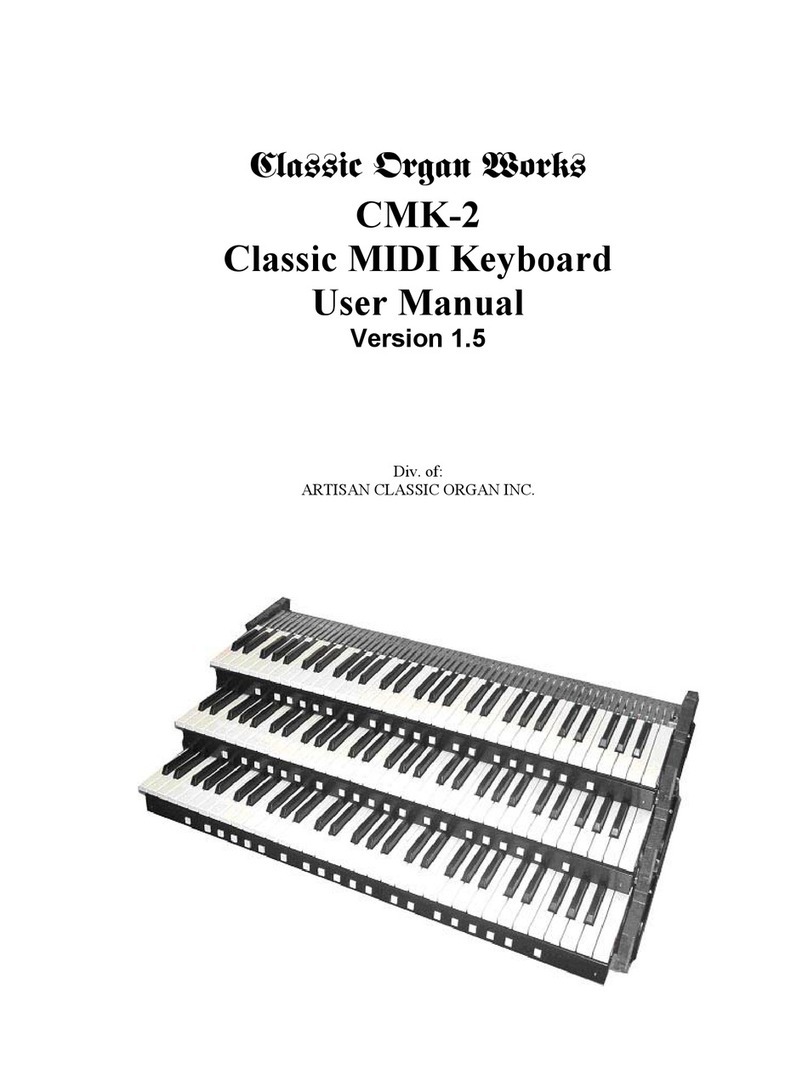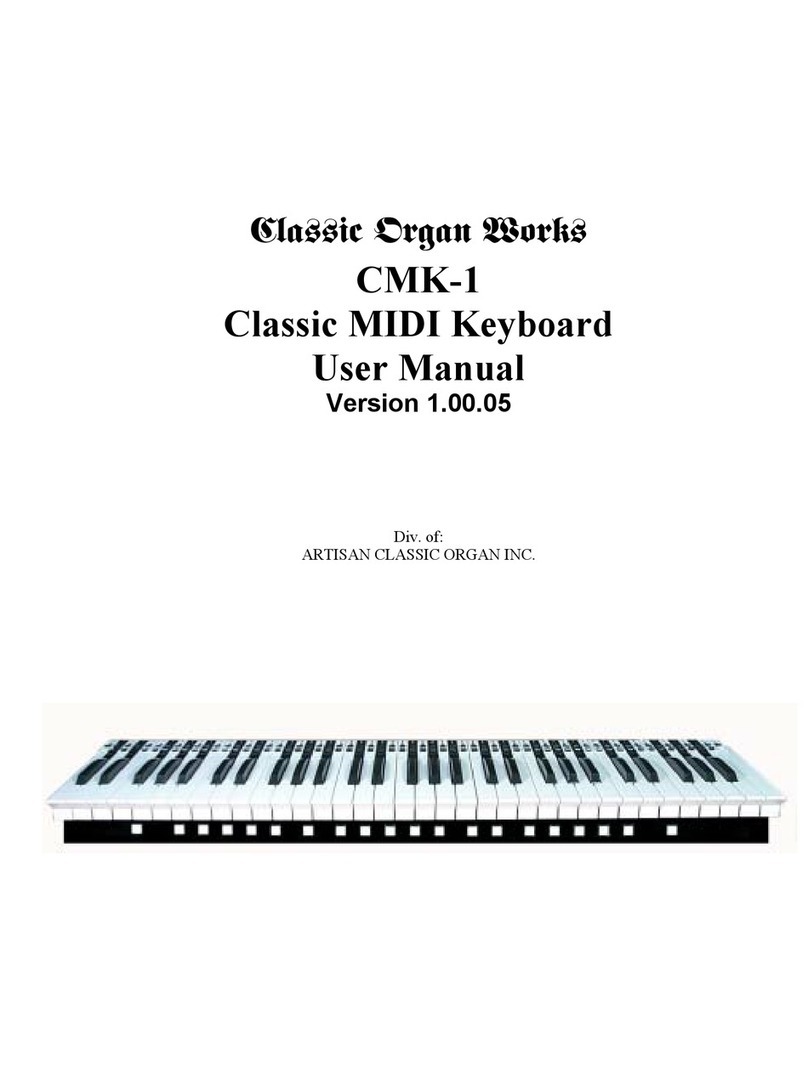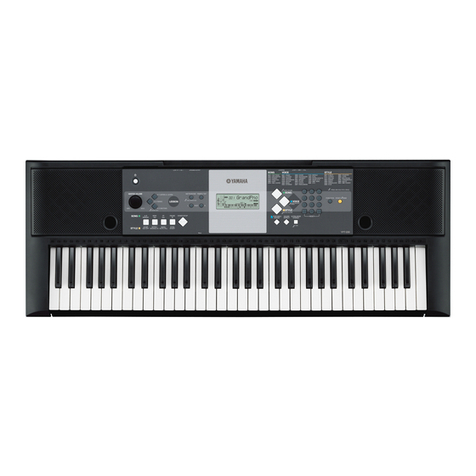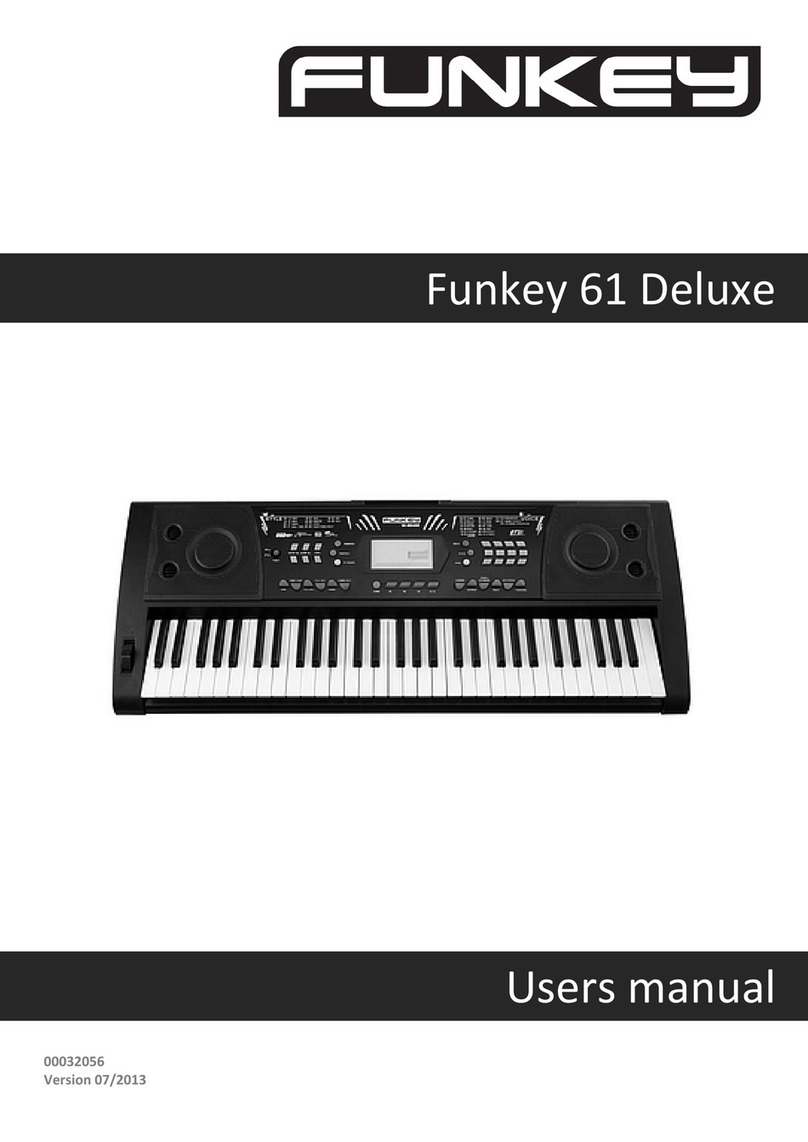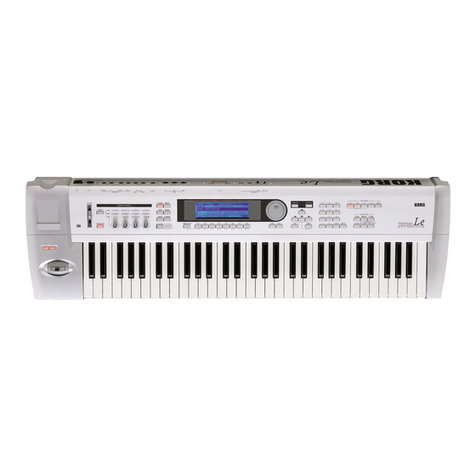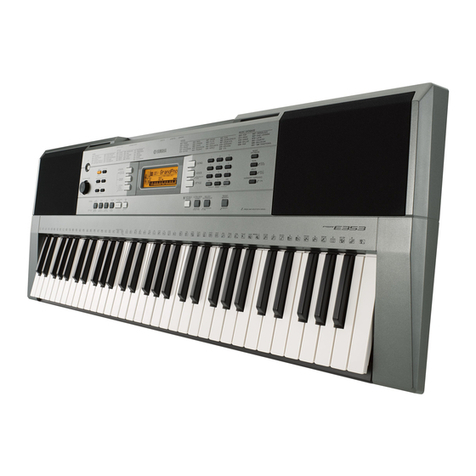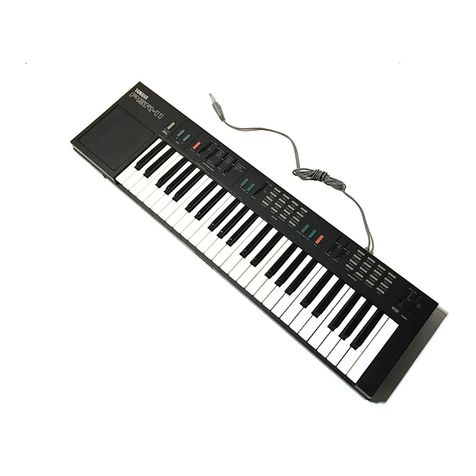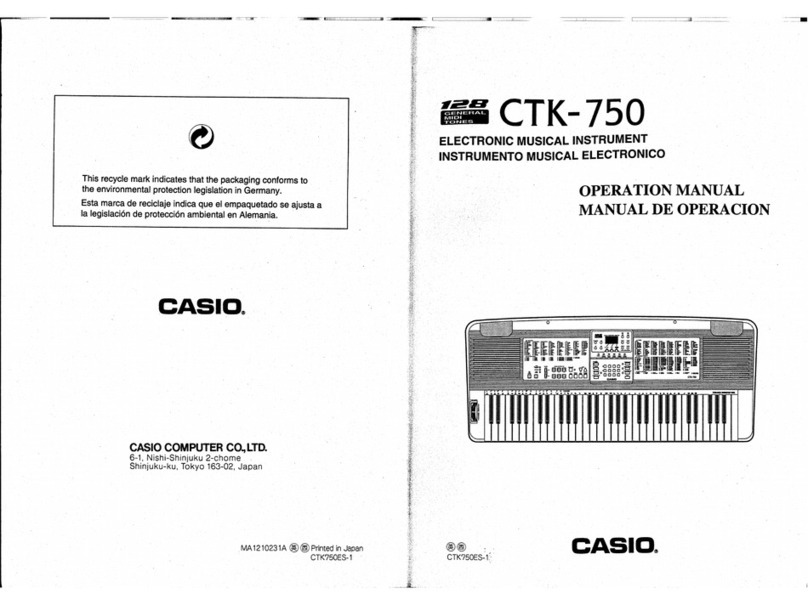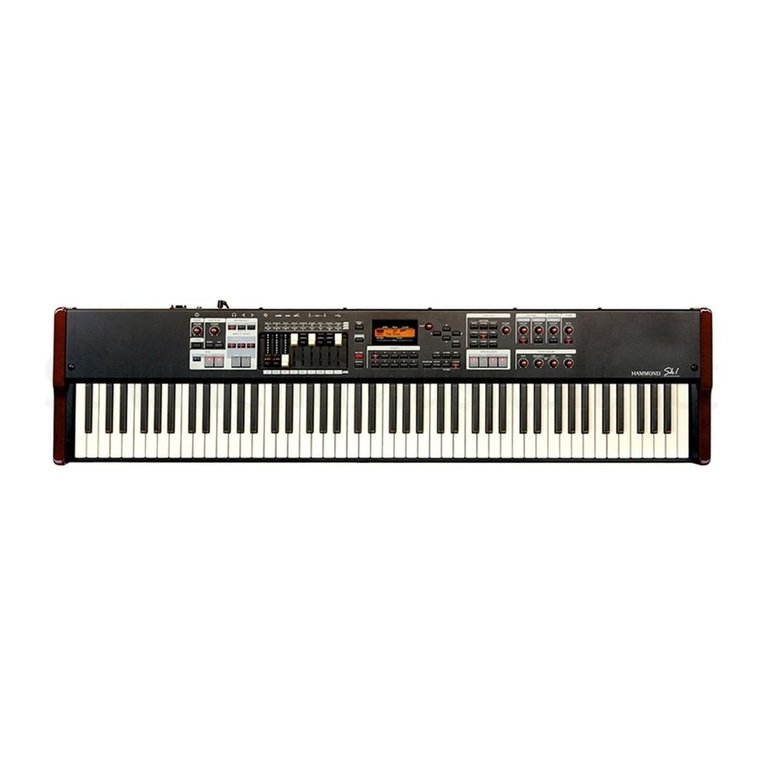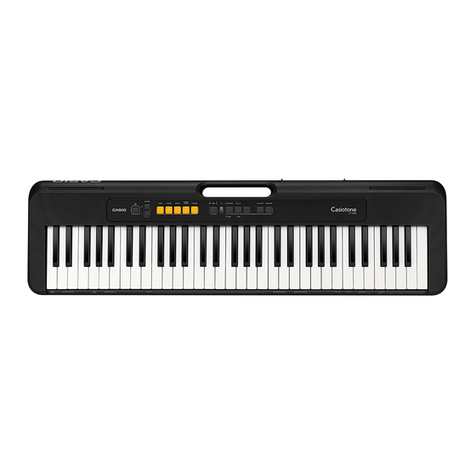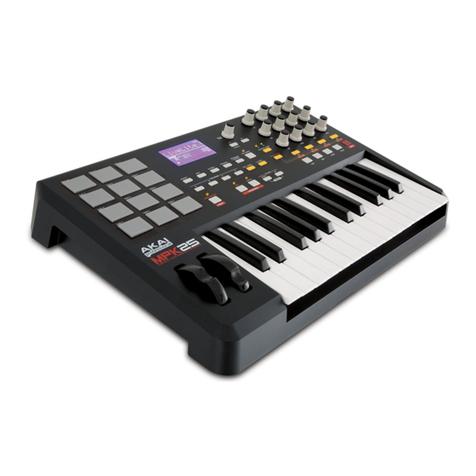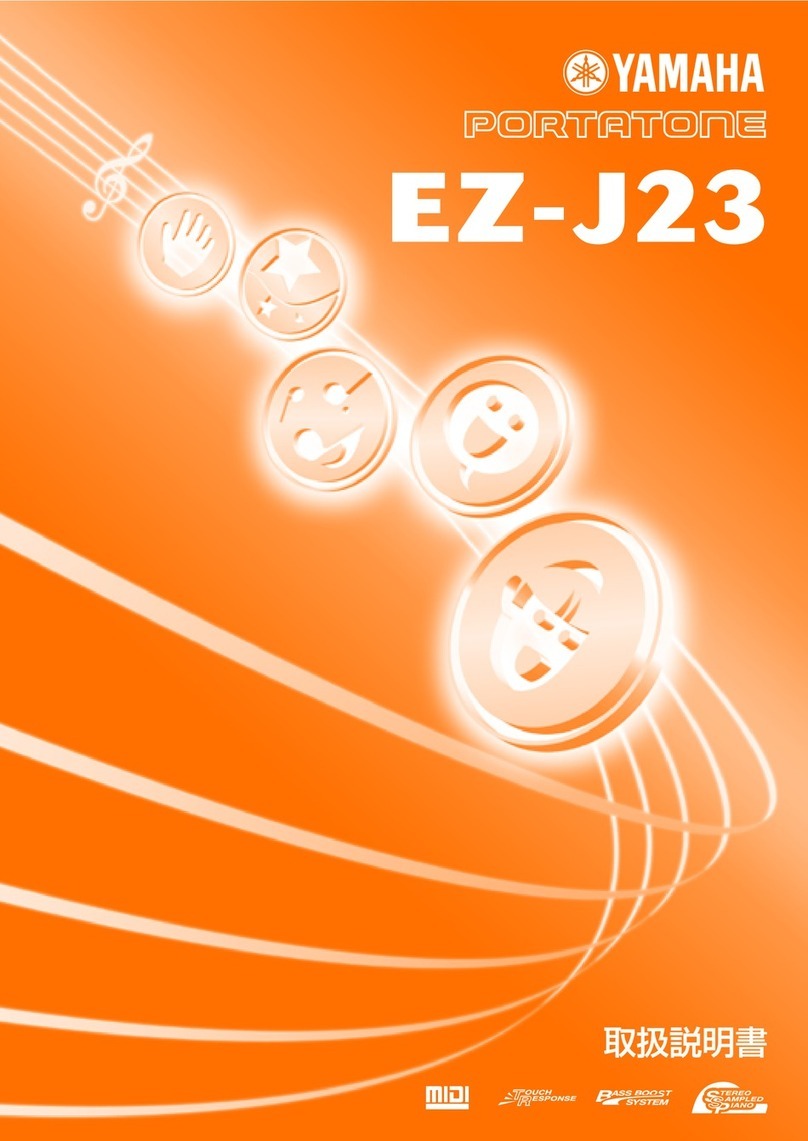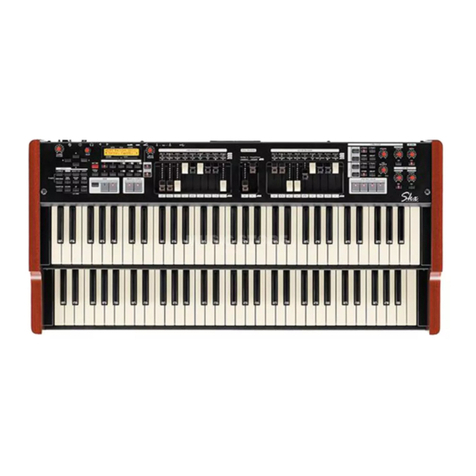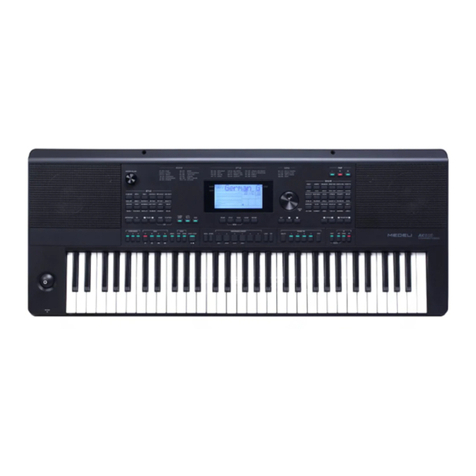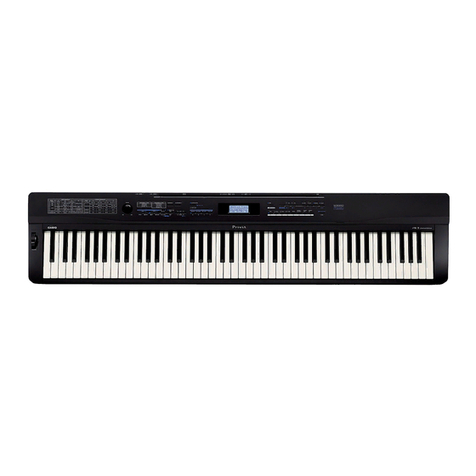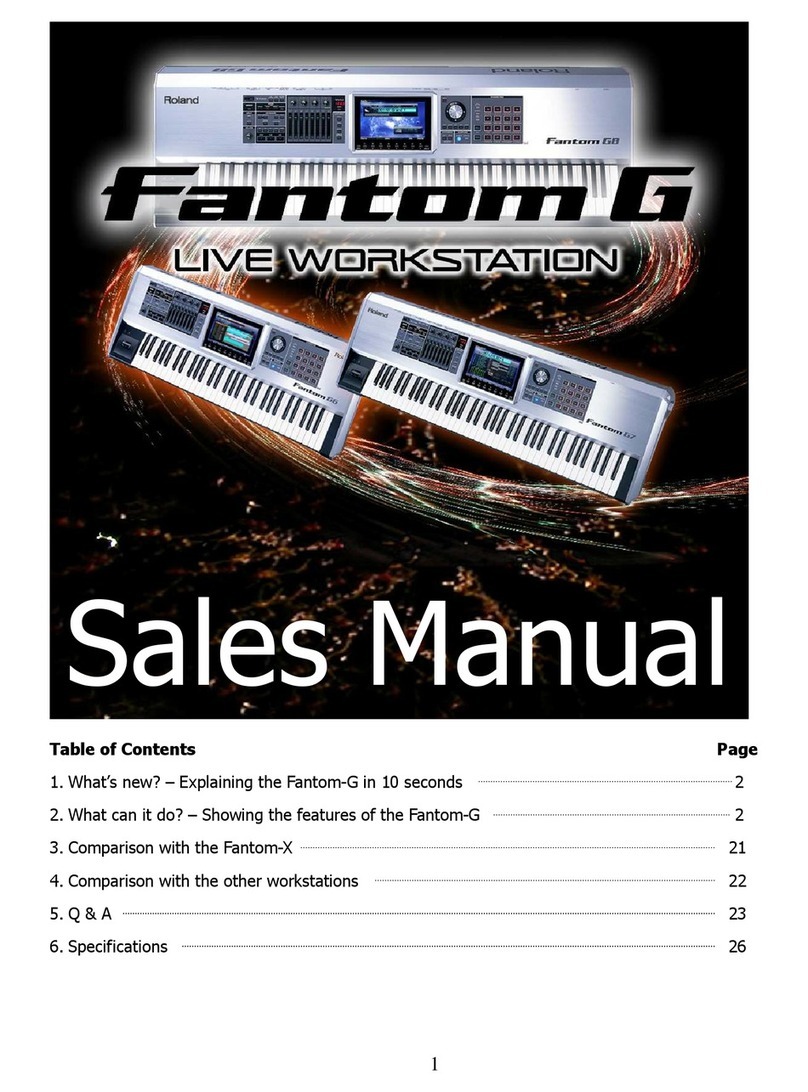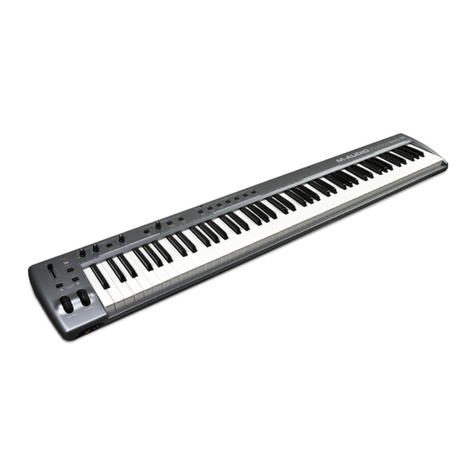Classic Organ Works CMK-2 User manual

1
Dmbttjd!Pshbo!Xpslt!
CMK-2
Classic MIDI Keyboard
User Manual
Version 1.00.00
Div. of:
ARTISAN CLASSIC ORGAN INC.

2
CLASSIC MIDI KEYBOARD
CMK-2
TABLE OF CONTENTS
LIMITED WARRANTY ............................................................................................... 7
INTRODUCTION ........................................................................................................ 9
Description......................................................................................................................................9
Package Contents.........................................................................................................................10
Table 1: Package Contents ..................................................................................................................................... 10
Figure 1: CMK-2 components (from L-R, Top to Bottom): ...................................................................................... 10
Figure 2: CMK-2 connections .................................................................................................................................. 11
INSTALLATION ....................................................................................................... 12
Physical Installation .....................................................................................................................12
Figure 3a: Bracket Installation ................................................................................................................................. 12
Figure 3b: Bracket Goes Over Top of the Keyboard Mount .................................................................................... 13
Figure 3c: Install 3 #8 Screws in the Underside ...................................................................................................... 13
Connections (Rear View) .............................................................................................................13
Figure 4: Rear View Connections ............................................................................................................................ 13
Power Connections ......................................................................................................................14
Figure 5: Power Terminal Block Connections ......................................................................................................... 14
MIDI Connections .........................................................................................................................15
Figure 6: Connecting MIDI Cables to a Keyboard Stack......................................................................................... 15
Connecting Swell Shoes ..............................................................................................................15
Figure 7 Wiring Schematic for Analog input ............................................................................................................ 16
Table 2: Connection Chart....................................................................................................................................... 16
Software Installation (Windows users only)............................................................................................................. 17
MIDI SPECIFICATION ............................................................................................. 18
Ahlborn..................................................................................................................................................................... 18

3
Table 3: Classic Module .......................................................................................................................................... 18
Table 4: Romantic Module........................................................................................................................................ 18
Table 5: 201 Module ................................................................................................................................................. 19
Table 6: 202 Module ................................................................................................................................................. 19
HAUPTWERKTM........................................................................................................................................................ 20
Table 7a: MIDI messages relevant to Hauptwerk .................................................................................................... 20
Table 7b: Configuration for 2 and 3 manual stack with Hauptwerk St. Anne Mosley............................................... 20
SCPOPTM .................................................................................................................................................................. 21
MIDI Hardware Specification .......................................................................................................21
Figure 8 Schematic of 5-pin DIN connector............................................................................................................. 22
CMK-2 HARDWARE CONFIGURATION................................................................. 23
Introduction...................................................................................................................................23
Power-On Self Test.......................................................................................................................23
Analog Input Pins .........................................................................................................................23
MIDI Crescendo – only for Ahlborn Archive modules.............................................................................................. 23
MIDI Volume ............................................................................................................................................................ 23
MIDI Expression....................................................................................................................................................... 23
Programming ................................................................................................................................24
Table 8: Piston programming functions .................................................................................................................... 24
CMK-2 SOFTWARE CONFIGURATION ................................................................. 26
Introduction...................................................................................................................................26
Software Installation.....................................................................................................................26
Figure 9 Upon clicking on the ‘CMK-2_Setup.exe’ file, the above window will appear. .......................................... 27
Figure 10 Allows the user to select a directory to install the CMK-2 program file ................................................... 27
Figure 11 Setup adds an icon to the start menu for convenient access.................................................................. 28
Figure 12 Setup provides the option of creating an icon on the Windows desktop................................................. 28
Figure 13 Confirmation window ............................................................................................................................... 29
Figure 14 Setup progress window ........................................................................................................................... 29
Figure 15 Confirms installation was successful....................................................................................................... 30
Software Startup ...........................................................................................................................31
Figure 16 CMK-2Config software startup screen. ................................................................................................... 31
Figure 17 CMK-2Config software main menu. ........................................................................................................ 31
Configure a CMK-2 from scratch.................................................................................................32
Figure 18 CMK-2Config software attempting to connect with the CMK-2 ............................................................... 32
Figure 19 CMK-2Config software unable to connect............................................................................................... 32
Figure 20 CMK-2Config software successfully connected to the CMK-2................................................................ 32
Figure 21 Window confirms the loading of pre-configuration data from the CMK-2 to the PC. .............................. 33
Load a previously saved CMK-2 configuration..........................................................................33
Figure 22: Configuration File selection window. ...................................................................................................... 34
Figure 23: Program window..................................................................................................................................... 34

4
Functions of the Toolbars............................................................................................................34
Figure 24: Toolbars in CMK-2Config software ........................................................................................................ 35
1. File Menu ............................................................................................................................................................ 35
Figure 25: Loading Program Data From File Window ............................................................................................. 35
Figure 26: Save Program Data to File Window ....................................................................................................... 36
Figure 27: Confirm replacing of file window............................................................................................................. 36
Figure 28: Software attempting to make a connection with the CMK-2 .................................................................. 36
Figure 29: Software unable to make a connection with the CMK-2 ........................................................................ 37
Figure 30: Software detecting number of keyboards............................................................................................... 37
Figure 31: Confirms loading of configuration into CMK-2Config software. ............................................................. 37
Figure 32: Software attempting to communicate with CMK-2 ................................................................................ 38
Figure 33: Confirms configuration written to CMK-2 from CMK-2Config software.................................................. 38
Figure 34: MIDI Input Output Setup window............................................................................................................ 38
Figure 35: Help Menu .............................................................................................................................................. 39
Keyboard Functions .....................................................................................................................39
Figure 36: Clicking on the keys of the keyboard invokes a MIDI Channel select menu.......................................... 40
Figure 37: Clicking on an individual piston invokes the Piston function select drop-down menu. .......................... 40
Table 9: Customizable Functions for each piston ................................................................................................... 41
Figure 38: Clicking on the “Configure Shoe” button invokes the Expression Shoe Setup menu. ........................... 42
Configuring Multiple Keyboards .................................................................................................42
REFERENCES ......................................................................................................... 43
APPENDIX A: .......................................................................................................... 44
SYSTEM EXCLUSIVE MESSAGE LAYOUTS ........................................................ 44
Messages common to all products .............................................................................................44
General Information Identity Request...................................................................................................................... 44
General Information Identity Reply .......................................................................................................................... 44
CMK-2 -- Special layouts..............................................................................................................44
APPENDIX B: .......................................................................................................... 47
AHLBORN MESSAGES .......................................................................................... 47
Table 10: Note On/Off MIDI functions to control Ahlborn Archive sound modules .................................................. 47
Table 11: Ahlborn Archive ‘ROMANTIC’ sound module commands for stops and couplers ................................... 47
Table 12: Ahlborn Archive ‘CLASSIC’ sound module commands for stops and couplers on .................................. 49
Table 13: Ahlborn Archive ‘202’ sound module commands for stops and couplers................................................. 50
Table 14: Ahlborn Archive ‘201’ sound module commands for stops and couplers................................................. 51
Table 15: Ahlborn Archive sound module Piston and Crescendo input functions for all four units.......................... 52
Table 16: Ahlborn Archive sound module additional Piston input commands .........................................................53
Table 17: Ahlborn Archive and other MIDI sound modules analog input function commands................................. 53
APPENDIX C: .......................................................................................................... 55
CIRCUIT BOARD SCHEMATICS ............................................................................ 55

5
Figure 39: CMK-2A- SS Classic MIDI Keyboard Circuit board Silk Screen ........................................................... 55
Figure 40: CMK-2A Classic MIDI Keyboard Circuit Board Schematic .................................................................... 56
Figure 41: CMK-2 PR-S-SSC v.1 Classic Midi Keyboard Piston Rail Silk Screen.................................................. 57
Figure 42: CMK-2 PR-S-S v.1 Classic MIDI Keyboard Piston Rail Schematic ....................................................... 58
APPENDIX D: .......................................................................................................... 59
MECHANICAL DRAWINGS..................................................................................... 59
Figure 43: CMK-2 Piston Rail Front Panel Mechanical Drawing............................................................................. 60
APPENDIX E:........................................................................................................... 61
MIDI AND SCPOP RESOURCES ............................................................................ 61
APPENDIX F:........................................................................................................... 62
ASSEMBLY PICTURES........................................................................................... 62
MATING THE BRACKETS ...................................................................................... 62
Figure 44: Small mounting bracket for top manual.................................................................................................. 62
Figure 45: Large mounting bracket for bottom and middle manuals ....................................................................... 62
Figure 46: Mating the Small and large Brackets...................................................................................................... 63
Figure 47: Connecting Two Brackets ...................................................................................................................... 63
Figure 48: Brackets mated and closed .................................................................................................................... 64
Figure 49: A Four Manual Stack Open .................................................................................................................... 64
Figure 50: A Four Manual Stack Closed.................................................................................................................. 65
Figure 51: A Completed Four Manual Stack ........................................................................................................... 65
DISCLAIMER ........................................................................................................... 66


7
CLASSIC MIDI KEYBOARD
CMK-2
LIMITED WARRANTY
Classic Organ Works warrants the Classic MIDI Keyboard (CMK-2) to be free from defects in materials and
workmanship under normal use for a period of ONE YEAR from the delivery date. This warranty applies
only if the product is owned by the original purchaser who has the bill of sale.
This warranty explicitly excludes any cables provided with the CMK-2, which may become defective as a
result of normal wear and tear. The DC power adaptor is included in the warranty however.
As soon as a defect is detected, contact Classic Organ Works. In particular, defects due to shipping should
be reported within 5 days for insurance claim purposes. For all other defects, Classic Organ Works agrees to
repair or replace all defective parts of said products which are returned, transportation prepaid, for inspection
at its service centre within the period of the warranty.
In the event that Classic Organ Works determines the product requires repair because of user misuse or
regular wear, it will assess a fair repair or replacement fee. The customer will have the option to pay this fee
and have the unit repaired and returned, or not pay this fee and have the unit returned un-repaired.
Classic Organ Works will not be liable for consequential, special, indirect, or similar damages or claims
including loss of profit or any other commercial damage, and in no event will Classic Organ Works’ liability
for any damages to the purchaser or any other person exceed the price paid for the product, regardless of any
form of the claim. Classic Organ Works specifically disclaims all other warranties, expressed or implied.
Specifically, Classic Organ Works makes no warranty that the product is fit for any particular purpose.
This warranty shall be interpreted, and governed by applicable laws in the province of Ontario, Canada. If
any provision of this warranty is found void, invalid or unenforceable, it will not affect the validity of the
balance of the warranty, which shall remain valid and enforceable according to its terms. In the event any
remedy hereunder is determined to have failed of its essential purpose, all limitations of liability and
exclusion of damages set forth herein shall remain in full force and effect.


9
CLASSIC MIDI KEYBOARD
CMK-2-1
INTRODUCTION
Description
The CMK-2 is a MIDI keyboard controller designed for the modern organist. It combines technology and classical church organ
ideas into an innovative MIDI device.
The keyboard features:
•Tracker organ style key action
•User-programmable pistons
•A stacking mechanism for mounting multiple manuals in a traditional organ configuration
•Inputs for expression shoes
•Velocity sensitive (optional)
With the CMK-2, MIDI software and sound modules may be controlled as if they were part of the organ. The CMK-2 is designed
to work with all of your favorite hardware and software, including:
•Crumhorn Labs’ Hauptwerk virtual organ software
•Ahlborn-Galanti’s Archive MIDI sound modules
•Miditzer virtual organ software
•Products capable of being controlled by standard MIDI messages
Enjoy your new CMK-2!

10
Package Contents
Table 1: Package Contents
Items
Setup
Manual(s) Stacking Bracket DC Adapter MIDI Cable(s)
1 Manual 1 2 x B 1 1
2 Manual 2 2 x B + 2 x C 1 2
3 Manual 3 2 x B + 4 x C 1 3
A B C
D E F
Figure 1: CMK-2 components (from L-R, Top to Bottom):
A) Keyboard
B) Fatar small mounting bracket
C) Fatar large mounting bracket
D) 12V DC wall adaptor
E) 6-Ft. MIDI cable
F) Mounting screw.

11
Figure 2: CMK-2 connections

12
CLASSIC MIDI KEYBOARD
CMK-2-1
INSTALLATION
IMPORTANT
READ THIS DOCUMENT BEFORE INSTALLATION
Upon receiving this unit, remove any packing material inside the unit that may have been included to
prevent movement of components or wiring during shipping.
(For internal access, ensure the unit is disconnected from all power sources.)
Physical Installation
The CMK-2 can be mounted into a traditional organ console or set on a table. The American Guild of Organists’
standard dimensions state that the top of the lower manual’s keys must be 29.5” from the top of the pedals. If the
standard Classic MIDI Pedalboard is used, the table must be 32.5”
Figure 3a: Bracket Installation

13
Figure 3b: Bracket Goes Over Top of the Keyboard Mount
First, sit the plastic supports on the end of each keyboard (figure 3b) and fasten them in place with the #8 screws from
underneath (figure 3c). Then stack the keyboards by sliding the slots on the upper supports over the pins on the lower
supports. To slide the upper supports into place, first tilt the keyboard up about 30 degrees. At that angle, the pins on
the lower supports will slide through the slots on the upper supports.
Figure 3c: Install 3 #8 Screws in the Underside
Connections (Rear View)
MIDI OUTMIDI OUT MIDI OUTMIDI IN
DC 12V INPUT 3 INPUT 2 INPUT 1
HEARTBEAT
LIGHT
+ O - + O - + O -
not used
Swell-shoe input for Ahlborn
Archive crescendo pedal
Standard swell-shoe input parallel outputs (all the same)
GND
+12V
MIDI OUT
POWER
TERMINAL
BLOCK
ABBA
Figure 4: Rear View Connections

14
Power Connections
Typical Usage:
If you are using multiple keyboards, connect the red and black wires as illustrated in the diagram below and then
connect the supplied DC power supply to circular power connector on the board. Make sure you use the red wires for
the +12V (the B) and the black wires for the Ground (the A)
DC 12V
POWE
R
TERMINAL
BLOCK
AABB
AABB
AABB
DC POWER
SUPPLY
Figure 5: Power Terminal Block Connections
Additional Information:
•If the CMK-2 is to be mounted in an existing organ, it can be connected to the organ power supply. See
schematic in appendix for details.
•The CMK-2 has a bridge-rectifier, and can accept power supply positive or negative center power supplies
•The CMK-2 requires between +9V and +15V DC at a minimum current of 400 mA. The co-axial input is 2.1
mm in diameter.
•A 500mA self-resetting Polyfuse provides over-current protection from the common power supply
.

15
MIDI Connections
MIDI OUTMIDI IN
Classic MIDI Pedalboard
(rear view)
MIDI IN MIDI OUT
MIDI Adapter
Connected
to PC
Ahlborn Archive and
other MIDI Modules
MIDI OUT
MIDI OUTMIDI OUT MIDI OUTMIDI IN
MIDI OUT
MIDI OUTMIDI OUT MIDI OUTMIDI IN
MIDI OUT
MIDI OUTMIDI OUT MIDI OUTMIDI IN
Manual 1
Manual 2
Manual 3
Figure 6: Connecting MIDI Cables to a Keyboard Stack
Connecting Swell Shoes
There are three terminal-blocks for analog input. Analog inputs are used for crescendo and volume/expression
adjustment as shown in Figure 4. Schematics for the analog and expression pedal inputs are in Figure 13.
Input 3: not used
Input 2: To this a swell shoe would be connected if it were to be used as a crescendo pedal for an Ahlborn
Archive module.

16
Input 1: To this a swell shoe is connect for use as a normal expression pedal or as a crescendo pedal. Which it
is to be used as is configured using CMK Config software on a personal computer.
Figure 7 Wiring Schematic for Analog input
The CMK-2 has provision for up to four extra input functions on the circuit board. These inputs are reserved for future
use.
Analog Input 1 is used explicitly for the Crescendo controls the Ahlborn Archive module. Analog Input 2 can be
configured by the CMK-2 Config software or the setup key sequence described in the
Programming section on page 24.
Table 2: Connection Chart
Connection Name Connection Type Hardware Description
Required Connections
Power Input 1. Co-ax 2.1mm (either polarity)
OR
2. 4-input Terminal Block
Input 1 for +12V, Input 2 for GND
9-12V, 400mA minimum
MIDI IN Input DIN 5-pin socket 180° Standard MIDI signals
MIDI OUT 1-4 Output DIN 5-pin socket 180° Standard MIDI signals
Optional Connections
Analog Input Pins, 0.025”Square,
0.3”long, 0.1”pitch
‘Analog Input 1’ is used for
crescendo and ‘Analog Input 2’ is
used for volume/expression.

17
Software Installation (Windows1users only)
Software installation instructions are described in the ‘CMK Configuration Software’ section of the manual.
Note: To use the software, the CMK-2 must be connected to a computer via MIDI. If a MIDI port is not available on
your computer, a commercial MIDI adapter for the game port, USB port, or parallel port may be used.
1Windows is a registered Trademark of the Microsoft Corporation.

18
CLASSIC MIDI KEYBOARD
CMK-2-1
MIDI SPECIFICATION
MIDI (Music Instrument Digital Interface) is a communication system between computer-controlled music
instruments and describes all the actions of a musical performance. It was originally developed for music synthesizers
but, a few years ago, organ-builders began adding MIDI capabilities to pipe organs. However, as MIDI was not
designed for a complex musical instrument such as the organ, its standards are subject to organ-builders preferences.
MIDI is composed of three components which are the language (protocol), hardware (MIDI connector), and
distribution format (MIDI file) [1]. The MIDI language is in binary format and is a uni-directional asynchronous
stream of bits at 31.25 Kbits per second with 10 bits transmitted per byte. The 10 bits per byte consist of a start bit, 8
data bits, and a stop bit. In the hardware domain, the MIDI 1.0 Specification (maintained by the MIDI Manufacturers
Association) recommends the 5-pin DIN 180° connector. The 5-pin DIN connector is standard and allows MIDI
equipment from differing manufacturers to be connected together. MIDI cables transmit information in a uni-
directional manner so connectors are designated as either input or output. MIDI files are the standard distribution
format. They capture all the details of MIDI onto a hardcopy medium. MIDI files are similar to the MIDI language
except that they add a time-stamp for each event so that MIDI equipment can replicate the timing required to generate
accurate performances. [1] MIDI Message information can be found at www.midi.org.
Ahlborn [2]:
The Ahlborn Archive modules allow additional pipe organ sounds to be played on an existing organ. There are four
separate Ahlborn Archive modules of 20 different stops each over three separate divisions. For more information on
Ahlborn Archive modules, please visit: http://www.ahlbornorgans.com/archive. The messages for controlling Ahlborn
Archive modules can be found in Appendix D. The stop list for each module is shown below.
Table 3: Classic Module [3]
Division A Division B Pedal
Description Description Description
Gemshorn 8’ Principal 8’ Contre Basse 32’
Gemshorn Celeste 8’ Holzgedackt 8’ Contre Gambe 16’
Flûte à cheminée 8’ Flûte Harmonique 8’ Contre Bombarde 32’
Koppelflöte 4’ Flûte Octaviante 4’ Bombarde 16’
Plein Jeu IV-V Octave 2’ Div. A to Ped.
Bombarde 16’ Cymbale III Div. B to Ped.
Harmonic Trumpet 8’ Tremulant
Corno di Bassetto 8’ Div. A to Div. B
Festival Trumpet 8’
Clarion 4’
Tremulant
Div. B to Div. A
Table 4: Romantic Module [3]

19
Division A Division B Pedal
Description Description Description
Cello 8’ Open Diapason 8’ Contre Violone 32’
Cello Celeste 8’ Flauto Mirabilis 8’ Contre Gambe 16’
Cornet des Bombardes IV Concert Flute 4’ Contre Bassoon 32’
Cornopean 16’ Quint Flute 2 2/3’ Ophicleide 16’
Clarinet 8’ Piccolo 2’ Div. A to Ped.
Orchestral Oboe 8’ Vox Humana 8’ Div. B to Ped.
French Horn 8’ Tremulant
Cor Anglais 8’ Div. A to Div. B
Tuba Mirabilis 8’
Clarion 4’
Tremulant
Div. B to Div. A
Table 5: 201 Module [3]
Division A Division B Pedal
Description Description Description
Bourdon 16’ Gedackt 8’ Subbass 16’
Principal 8’ Gamba 8’ Octave 8’
Flûte à cheminée 8’ Nachthorn 4’ Bourdon 8’
Unda Maris 8’ Cymbale III Posaune 16’
Octave 4’ Cornet III Div. A to Ped.
Spitzflöte 2’ Oboe 8’ Div. B to Ped.
Nasard 2 2/3’ Tremulant
Superoctave 2’ Div. A to Div. B
Mixture IV
Trompete 8’
Tremulant
Div. B to Div. A
Table 6: 202 Module [3]
Division A Division B Pedal
Description Description Description
Contregambe 16’ Bourdon 8’ Soubasse 32’
Diapason 8’ Flûte harmonique 8’ Violone 16’
Quintadena 8’ Flûte octaviante 4’ Contrebombarde 32’
Terz 1 3/5’ Larigot 1 1/3’ Bombarde 16’
Septime 1 1/7’ Corno di bassetto 8’ Div. A to Ped.
Scharff III Clarion 4’ Div. B to Ped.
Bombarde 16’ Tremulant
Trompette 8’ Div. A to Div. B
Tuba Mirabilis 8’
Chimes
Tremulant
Div. B to Div. A

20
HAUPTWERKTM [4]
Hauptwerk 2 (German for ‘Great Organ’) is a computer simulation of a pipe organ. It produces a realistic organ sound
by use of a ‘virtual sampler’ technique. Traditionally, synthesizers used a small number of samples by recording keys
at intervals across the keyboard. In order to simulate all the keys, the samples were time-stretched. Hauptwerk 2uses
a 3 to 10 second sample of every pipe in the organ. To accommodate the intensive requirement for memory, a high-
speed personal computer must be used. With current technology, thousands of individual sample sounds can be stored
and recalled when a key is pressed. Thus, the software is able to capture many different and customizable organ
configurations and sounds which can be loaded via ‘.organ’ files. The ‘.organ’ file contains information regarding
number of stops, pistons, and keyboards in addition to other organ-related details.
The CMK-2 provides an interface for volume controls, expression controls, and pistons. MIDI messages will then be
sent through the MIDI out port to the personal computer where Hauptwerk software will translate the MIDI message
commands into actions on the organ. A table listing the types of messages sent for the individual functions is shown
below.
Table 7a: MIDI messages relevant to Hauptwerk
Function MIDI command
Keyboards 1. Note on/off
2. Channel number
3. Key number
Pedalboard 1. Note on/off
2. Channel number
3. Key number
Stops Note on/off
Pistons Program change
Volume Program change
Expression Program change
Crescendo Program change
Table 7b: Configuration for 2 and 3 manual stack with Hauptwerk St. Anne Mosley
CMK Config Software General Settings Organ Settings
Physical
Position
CMK Config
Name
CMK
Config
MIDI Out
MIDI
Channel
In
Keyboard
Div #
Keyboard
MIDI In
Connect MIDI In
to Organ
Keyboard
Swell #1 3 3 3 Swell Swell
Great #2 2 2 2 Great Great
Choir #3 1 1 4 Choir n/a
Pedal n/a n/a 4 1 Pedal Pedal
This table assumes you are using our pedalboard and that it is wired and connected as per Figures 4,5,and 6
Other manuals for CMK-2
1
Table of contents
Other Classic Organ Works Electronic Keyboard manuals
